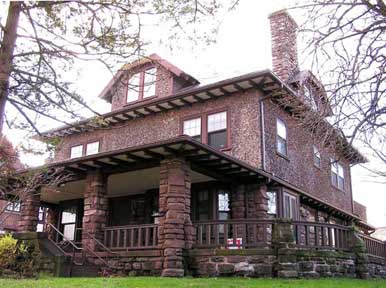Architecture
styles - Table of Contents
The
Arts and Crafts (Craftsman) Style
1860-1930
(American:
1905-1930)
|
5.1.10 Craftsman/ Bungalow (1905-1930) The
Craftsman style became the dominate style for smaller houses
constructed throughout the country in the first decades of the
twentieth-century. Developing as a response to the chaotic
ornamentation of the Victorian-era which dominated the late
nineteenth-century, the Craftsman movement emphasized the beauty
of natural materials such as wood, stone and metals. The
American Craftsman movement drew heavily on the ideals of the
British Craftsman movement, founded by William Morris in the
1860s, who promulgated a return to hand-made and traditional
production in response to the mechanization of the Industrial
Revolution and the diminished role of worker as craftsman. -
Clinton
Brown Company Architecture/Rebuild: High
& Locust Streets Historic District Nomination, Sec
5,p. 2 |
 Arts & Crafts Houses in Buffalo Hannah Bachman, Craftsman Houses |
| Elbert Hubbard and the Roycrofterss |
| Gustav Stickley |
| Charles
Rohlfs
and Anna Katharine Green |
| Prairie Houses |
| American Foursquare Style |
| Bungalows |
| Examples
of Arts & Crafts Stained Glass in Buffalo |
|
(not
universally classified as Arts & Crafts)
|
|
Colonial
Revival |
|
Art
Nouveau |
| Arts & Crafts Movement in England |
|
Museum
of the American Arts and Crafts Movement, |
Arts & Crafts Furniture:
Arts & Crafts Stained Glass:

web site consulting by ingenious, inc.